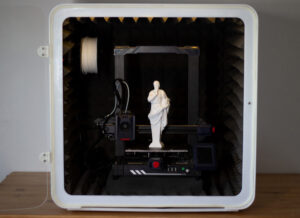Introduction

3D printer enclosure: In the world of 3D printing, the quality and longevity of printed products directly depend on the conditions under which the 3D printer operates. One of the key aspects is creating an ideal 3d printer enclosure for your device. This article will explore the five most important secrets that will help you protect your 3D printer and ensure its efficient and safe operation.
Benefits of Stable Temperature in a 3D Printer Enclosure
1. Minimizing Material Deformation
An unstable temperature in the workspace of the 3D printer can lead to material deformation. This is particularly relevant for plastics like ABS and PLA. These materials tend to shrink and crack with sudden temperature changes. A enclosure helps maintain a constant temperature. This minimizes the risk of deformation and improves the quality of the final product. RDBox recommends using enclosures to ensure maximum stability during the printing process.
2. Improving Layer Adhesion
A constant temperature in the 3d printer enclosure improves the adhesion between material layers. When the temperature remains stable, layers bond better, preventing delamination and increasing product strength. This is especially important for printing complex objects. Experts from RDBox emphasize the importance of a stable temperature to ensure high print quality.
3. Even Cooling of Parts
Using a enclosure allows control of the cooling rate of printed parts. Rapid cooling can cause material stresses and cracks. An enclosure creates a controlled environment where cooling is more even. This improves surface quality and structural integrity. RDBox notes that even cooling helps avoid many printing errors.
4. Protection from External Influences
A enclosure protects the printer’s workspace from drafts and environmental temperature fluctuations. This is particularly important in rooms with an unstable climate. Protection from external influences ensures stable printing conditions and prevents potential defects. RDBox advises using enclosures in environments where constant temperature cannot be guaranteed.
Comparison with Printing Without a Enclosure
1. Influence of the Environment
When printing without a enclosure, the printer is exposed to external influences like drafts and temperature fluctuations. This can lead to uneven cooling and material deformation. Using an enclosure helps create a controlled environment, minimizing the impact of external factors. RDBox confirms that stable temperature significantly improves printing results.
2. Surface Quality
One of the main advantages of printing with an enclosure is improved surface quality. With stable temperature, material layers bond evenly, resulting in a smoother and more uniform surface. Without an enclosure, achieving this effect is more challenging due to potential temperature fluctuations. RDBox observes that customers often notice improved surface quality when using enclosures.
3. Use of Various Materials
Using an enclosure enables efficient printing with materials requiring strict temperature control, like ABS or Nylon. Without an enclosure, working with these materials can be difficult. An enclosure expands the range of materials and improves print results. RDBox recommends enclosures for printing with various materials.
Practical Tips for Using a Enclosure
1. Choosing the Right Enclosure
When selecting a enclosure, consider its size, material, and construction. The enclosure should be spacious enough for the printer to work freely and provide reliable thermal insulation. RDBox offers a wide range of enclosures for different printer models.
2. Temperature Control
For best results, use thermometers and thermostats to monitor the temperature inside the enclosure. This helps maintain stable conditions and prevent overheating or overcooling. RDBox advises installing a temperature monitoring system in the enclosure.
3. Regular Maintenance
Regular maintenance of the enclosure and the printer helps avoid dust and other contaminants that can affect the printing process. Cleaning and checking the equipment’s condition should be a regular part of working with the printer. RDBox emphasizes the importance of regular maintenance to maintain high print quality.
4. Ensuring Ventilation
Some materials, like ABS, can release harmful fumes during printing. It is important to ensure good ventilation in the enclosure to avoid the accumulation of harmful substances and ensure safety. RDBox recommends using ventilation systems in the enclosure to remove fumes.
Conclusion
Using a 3d printer enclosure for the 3D printer is an important factor in improving print quality. A stable temperature in the enclosure minimizes deformation, improves layer adhesion, reduces cooling time, and protects from external influences. Compared to printing without an enclosure, the benefits include better surface quality and the ability to use various materials. By following our practical tips and RDBox recommendations, you can achieve excellent 3D printing results and significantly improve your product quality.
